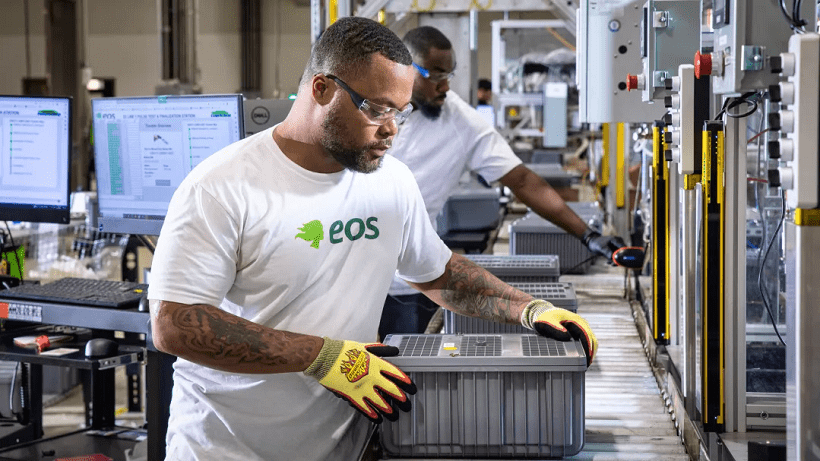The US Department of Energy just committed a $400 million loan to battery maker Eos.
One of the leading companies offering alternatives to lithium batteries for the grid just got a nearly $400 million loan from the US Department of Energy.
Eos Energy makes zinc-halide batteries, which the firm hopes could one day be used to store renewable energy at a lower cost than is possible with existing lithium-ion batteries.
The loan is the first “conditional commitment” from the DOE’s Loan Program Office to a battery maker focused on alternatives to lithium-ion cells. The agency has previously funded lithium-ion manufacturing efforts, battery recycling projects, and other climate technologies like geothermal power.
Today, lithium-ion batteries are the default choice to store energy in devices from laptops to electric vehicles. The cost of these kinds of batteries has plummeted over the past decade, but there’s a growing need for even cheaper options. Solar panels and wind turbines only produce energy intermittently, and to keep an electrical grid powered by these renewable sources humming around the clock, grid operators need ways to store that energy until it is needed. The US grid alone may need between 225 and 460 gigawatts of long-duration energy storage capacity by 2050.
New batteries, like the zinc-based technology Eos hopes to commercialize, could store electricity for hours or even days at low cost. These and other alternative storage systems could be key to building a consistent supply of electricity for the grid and cutting the climate impacts of power generation around the world.
In Eos’s batteries, the cathode is not made from the familiar mixture of lithium and other metals. Instead, the primary ingredient is zinc, which ranks as the fourth most produced metal in the world.
Zinc-based batteries aren’t a new invention—researchers at Exxon patented zinc-bromine flow batteries in the 1970s—but Eos has developed and altered the technology over the last decade.
Zinc-halide batteries have a few potential benefits over lithium-ion options, says Francis Richey, vice president of research and development at Eos. “It’s a fundamentally different way to design a battery, really, from the ground up,” he says.
Eos’s batteries use a water-based electrolyte (the liquid that moves charge around in a battery) instead of organic solvent, which makes them more stable and means they won’t catch fire, Richey says. The company’s batteries are also designed to have a longer lifetime than lithium-ion cells—about 20 years as opposed to 10 to 15—and don’t require as many safety measures, like active temperature control.
There are some technical challenges that zinc-based and other alternative batteries will need to overcome to make it to the grid, says Kara Rodby, technical principal at Volta Energy Technologies, a venture capital firm focused on energy storage technology. Zinc batteries have a relatively low efficiency—meaning more energy will be lost during charging and discharging than happens in lithium-ion cells. Zinc-halide batteries can also fall victim to unwanted chemical reactions that may shorten the batteries’ lifetime if they’re not managed.
Those technical challenges are largely addressable, Rodby says. The bigger challenge for Eos and other makers of alternative batteries will be manufacturing at large scales and cutting costs down. “That’s what’s challenging here,” she says. “You have by definition a low-cost product and a low-cost market.”
Batteries for grid storage need to get cheap quickly, and one of the major pathways is to make a lot of them.
Eos currently operates a semi-automated factory in Pennsylvania with a maximum production of about 540 megawatt-hours annually (if those were lithium-ion batteries, it would be enough to power about 7,000 average US electric vehicles), though the facility doesn’t currently produce at its full capacity.
The loan from the DOE is “big news,” says Eos CFO Nathan Kroeker. The company has been working on securing the funding for two years, and it will give the company “much-needed capital” to build its manufacturing capacity.
Funding from the DOE will support up to four additional, fully automated lines in the existing factory. Altogether, the four lines could produce eight gigawatt-hours’ worth of batteries annually by 2026—enough to meet the daily needs of up to 130,000 homes.
The DOE loan is a conditional commitment, and Eos will need to tick a few boxes to receive the funding. That includes reaching technical, commercial, and financial milestones, Kroeker says.
Many alternative battery chemistries have struggled to transition from working samples in the lab and small manufacturing runs to large-scale commercial production. Not only that, but issues securing funding and problems lining up buyers have taken down startups with a wide range of alternative chemistries in just the past decade.
It can be difficult to bring alternatives to the market in energy storage, Kroeker says, though he sees this as the right time for new battery chemistries to make a dent. As renewables are rushing onto the grid, there’s a much higher need for large-scale energy storage than there was a decade ago. There’s also new support in place, like tax credits in the Inflation Reduction Act, that make the business case for new batteries more favorable.
“I think we’ve got a once-in-a-generation opportunity now to make a game-changing impact in our energy transition,” he says.

